This article was published in Scientific American’s former blog network and reflects the views of the author, not necessarily those of Scientific American
A vast amount of evidence – encompassing virtually every subject in the natural sciences – demonstrates that our planet has a long, complex history, that life emerged following chemical innovations involving self-replicating molecules, and that the vast panoply of organisms living and extinct owe their existence to a gradual process in which changes are heritable and descendants become ever more distinct from their forebears. Yet significant sectors of the population in many parts of the world ignore or reject this view and rely instead on strict interpretations of religious texts. Is there a contradiction between religion and an evolutionary, Old Earth view of the natural world? While this varies from one religion to the next, scarcely any religion is specific enough to contradict, in detail, our scientific understanding of life, history, Earth and the universe as it has developed over recent centuries.
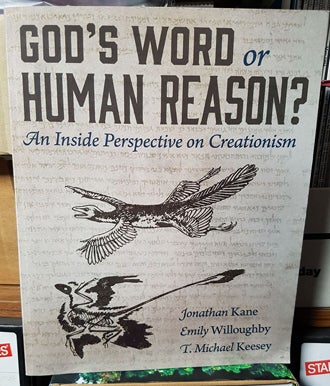
The cover illustration riffs on the idea that the four-winged feathered dinosaur Microraptor (shown at bottom) was essentially predicted by the ‘Tetrapteryx’ creature imagined by William Beebe in 1915. Credit: Darren Naish
Jonathan Kane et al.’s 2016 God’s Word or Human Reason? An Inside Perspective on Creationism (UPDATE: BUY SIGNED COPIES DIRECT FROM THE AUTHORS HERE) had its beginnings in the 2007 opening of the Answers in Genesis (AiG) Creation Museum of Petersburg, Kentucky. So much media coverage and so much apparent interest was generated by this event that – so Kane and co-author Emily Willoughby realised – clear and comprehensive response was warranted. A book was the only workable solution. And this book needed to cover geological history and dating, a review of ‘flood geology’, and reviews of our knowledge on dinosaurs and hominids, all areas that AiG mangles and distorts via its many Young Earth Creationist (YEC) claims. Further, AiG’s specific brand of young Earth creationism is so wrought and peculiar that effective counter requires insider knowledge and experience of the YEC literature, which is quite the thing to behold and little known, or unknown, to the majority of mainstream scientists.
On supporting science journalism
If you're enjoying this article, consider supporting our award-winning journalism by subscribing. By purchasing a subscription you are helping to ensure the future of impactful stories about the discoveries and ideas shaping our world today.

According to creationists like AiG’s Ken Ham, this statue – showing St Michael defeating the devil in reptilian form – represents an event that actually happened in real life, except the reptile-type creature should be imagined as a non-bird dinosaur known from the fossil record, perhaps a Baryonyx. You might think I’m joking, but YEC literature shows that I’m not. This statue is on St Michael’s Mount, Cornwall. Credit: Darren Naish
The title of this book – God’s Word or Human Reason? – is a response to AiG’s opening gambit: that the evolutionary, Old Earth view of science is merely the product of ‘human reason’ (AiG’s specific term), and that we do better to reject it in favour of accepting ‘God’s word’ (again, AiG’s specific term) (see the photo used in the opening of this article).
Yet, as Kane explains in Chapter 1, a religious Christian view would be that human reason is a gift from God, that God has left copious data by which we can evaluate the formation of the universe, the Earth, and the living things upon it, and that the Bible itself has long been established contradictory with evidence (example: “the Catholic Church believed that the Bible contradicts the idea of a mobile Earth”) (Kane 2016a, p. 5).
This book, then, does not set out to convert any Christian to atheism, nor is it hostile or unfriendly to Christianity or religion in general. While an atheist or non-Christian of any sort will find the book good and useful, it is predominantly written for Christians such that they appreciate the lack of contradiction between Christian faith and scientific knowledge, all the while denouncing the peculiar take promoted by AiG and YEC in general.

Like virtually all the atheists I know, I love churches, chapels and other places of worship. There is no contradiction in this view. Credit: Darren Naish
It has been said many times in the battle against the lies and miseducation of the creationists that among the most important opponents of YEC are those who were once YECs themselves. And here’s the kicker, because all the contributing authors of God’s Word or Human Reason? (there are five) are exactly that. Testimonials provided by each explain what it was that led them to doubt, question and ultimately reject YEC. These personal stories are fascinating, in one case heartbreaking.
As a physical object, this book is spectacularly well designed, with a size, feel and format that I really admire. The picture-to-text ratio (a non-trivial feature of design that is rarely mentioned but, in my experience, crucial to how we feel about works of scientific literature) is very near perfect, there being relatively few places where more than four consecutive pages lack illustrations of some sort. The quality of editing is extremely high and typos are few.
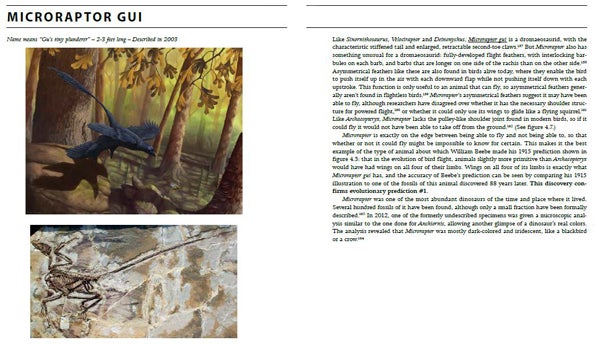
God’s Word or Human Reason? is very well illustrated. Kane’s chapter on created kinds and the origin of birds includes numerous wonderful illustrations by Emily Willoughby. Credit: Inkwater Press
As for the contents themselves, six chapters cover, variously, the nature of science and evolutionary theory (Kane, Chapter 1); the flood and the fossil record (Glenn Morton, Chapter 2); radiometric dating and the age of the Earth (Willoughby, Chapter 3); created kinds and the origin of birds (Kane, Chapter 4); human evolution (T. Michael Keesey, Chapter 5); and how we should interpret the Bible (James Comer, Chapter 6).
The scene is set with an introduction that covers the nature of the problem, the USA’s exceptionalism and the problem as exemplified by the views of congressmen and other politicians. The stated aim is to challenge and show wrong the claims of AiG; to demonstrate how AiG’s arguments are transparently inconsistent with easily understood evidence, presented here in abundant detail. Indeed, the chapters are thorough, well crafted and fantastically well researched.
Kane’s review of what we currently think about the evolution of birds from among theropod dinosaurs, for example, is one of the best reviews of this area yet published, combining historical review with a tour of key taxa in the ‘theropod to bird’ transition (Kane 2016b). The fact that fossil discoveries repeatedly matched predictions made about the evolutionary history of this group of animals is rightly emphasised. And what, then, of the AiG claim that the existence of a discrete ‘dinosaur kind’ and ‘bird kind’ is consistent with creationism, not evolution? (creationists use the term ‘baramin’ for these discrete ‘created kinds’).
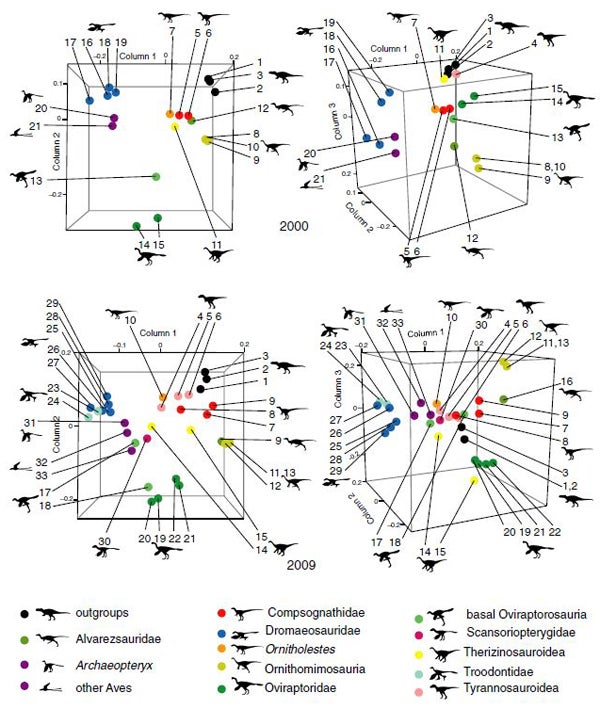
Tests of the ‘baraminological’ claims of the YECs (which assert that ‘dinosaur kinds’ and ‘bird kinds’ are distinct and were surely created differently) have been falsified, repeatedly, even in the statistical tests devised by YECs themselves. Palaeontologist Phil Senter (who has critically examined and tested YEC claims in several published articles, and is assuredly not a YEC) used these multidimensional tests himself in a 2011 paper, and some of his diagrams are shown here. These images show taxa known to science in 2000 and 2009, the obvious fact being that any perceived distinctions between groups are increasingly filled by newly discovered taxa. Credit: Senter 2011
Anyone actually aware of the large number of near-bird and early bird fossils discovered recently in the Jurassic and Cretaceous rocks of eastern Asia and elsewhere will be familiar with the fact that these animals are all – phylogenetically and metaphorically speaking – ‘shades of grey’ as goes any imagined boundary between ‘dinosaurs’ and ‘birds’, but the fun part for our discussion here is that even creationists themselves have announced this finding when they’ve used statistical techniques to determine the anatomical distance between the animals involved. Yes, a small field of creationist study termed baraminology aims to assert -- I mean test -- the difference between baramins. I have to mention that Senter (2011) also evaluated YEC baraminological writings on the theropod-bird transition.
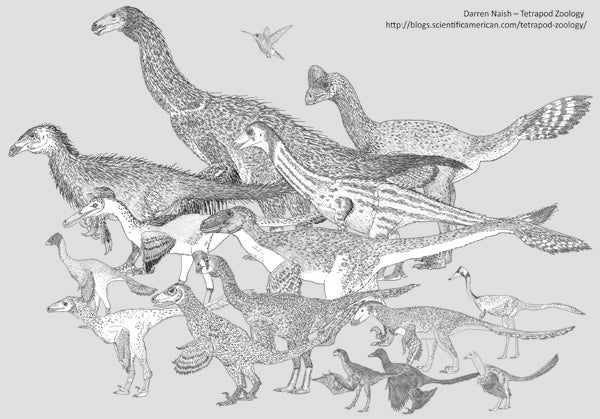
It might be obvious that the hummingbird at the top is a bird, but what about the other animals shown here? When it comes to near-birds and early birds known from the fossil record, it’s all shades of grey. Credit: Darren Naish
My favourite chapter – in that I found it most surprising and interesting, I guess – is, somewhat ironically, Glenn Morton’s on flood geology, in part because I hadn’t heard the full inside story on creationist interpretations of flood geology in such detail before (I say “somewhat ironically” only because geology is lower on my list of interests than dinosaurs and hominids). Besides marshalling the substantial evidence that counts against the existence of a global flood, Morton draws attention to the massive inconsistency present across YEC literature as YECs have struggled to account for geological and taphonomic evidence. And, as Morton shows, the wording in the Bible doesn’t require a global flood anyway.
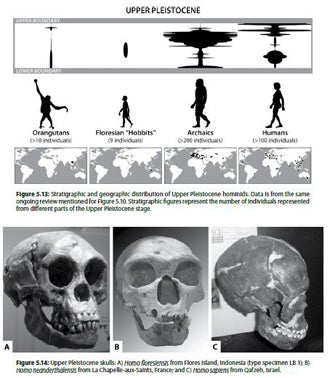
Keesey’s chapter on hominid evolution is a spectacular tour de force; again, it is wonderfully well illustrated, as demonstrated by this page of diagrams, maps and images of specimens. Credit: Inkwater Press
I also need to give special mention to T. Michael Keesey’s fantastic and very long chapter on hominids. Again, the AiG idea that the fossils of this group are either ‘fully ape’ or ‘fully human’ is transparently contradicted by the anatomical evidence. Rarely has such a quantity of information on the evidence linking humans with other apes been presented; Keesey discusses features of the integumentary, circulatory, nervous and skeletal system that tie humans to other apes before going on to review the hominin fossil record. The chapter is richly illustrated with images of fossils, graphs, maps, cladograms and silhouette reconstructions of the taxa involved. Those specially interested in the hominin fossil record should get the book for this chapter alone.
Appendices list those feathered dinosaurs relevant to Chapter 4 and the numerous traits (present across all biological systems) shared by humans and other apes, and relevant to Chapter 5. A substantial glossary and bibliography are included, and the book is fully indexed. The text is also highly up to date and fully and thoroughly referenced (Chapter 4 contains 300 citations; Chapter 5 a whopping 436).
All in all, I cannot recommend this book highly enough. As an educational outreach tool to Christians interested in learning about evolution and seeing evaluations and checks of the many doubtful or wrong claims made by AiG it is essential. But it is also just a very useful, very interesting book to people of any sort interested in evolution and approaches to it, and the reviews it includes are really strong. It is also very reasonably priced given its size and technical quality.

AiG have not just opened the Creation Museum: 2016 also saw the opening of the Ark Encounter, located just 70 km away in Williamstown, Kentucky. There is no credible reason for thinking that an ark ever existed, or that the beliefs promoted by AiG are at all reasonable as goes what we can actually understand about the world. Credit: Jameywiki Wikimedia(CC BY-SA 4.0)
Finally, it is clearly worthy and essential that Christian creationism be tackled, deconstructed and countered, and that its impact on education, public policy and social welfare be minimised. But Christian creationism is not the only brand of creationism that exists, nor are Christians the only community of people where creationist worldviews are common, nor are Christians like Ken Ham the only ones indulging in noisy promotion of anti-evolutionary rhetoric. I refer, of course, to Islamic creationism, and in particular to the highly dishonest writings of Harun Yahya (real name Adnan Oktar). Concerns about Islamic creationism have been prominent for years – in Turkey in particular – but how soon will it be before a volume, written for Muslims and countering Oktar’s many claims, appears in print?
Kane, J., Willoughby, E. & Keesey, T. M. 2016. God’s Word or Human Reason? An Inside Perspective on Creationism. Inkwater Press, pp. 389. ISBN 2370000384812. Here on amazon.Here on amazon.co.uk.
UPDATE: because amazon is WRONGLY stating that the book is out of stock, BUY IT DIRECTLY FROM THE AUTHORS HERE.
For previous Tet Zoo articles relevant to some of the issues touched on here, see...
Refs - -
Kane, J. 2016a. Chapter 1. God’s word or human reason? In Kane, J., Willoughby, E. & Keesey, T. M. God’s Word or Human Reason? An Inside Perspective on Creationism. Inkwater Press, pp. 1-11.
Kane, J. 2016b. Chapter 4. Created kinds and the origin of birds. In Kane, J., Willoughby, E. & Keesey, T. M. God’s Word or Human Reason? An Inside Perspective on Creationism. Inkwater Press, pp. 105-180.
Senter, P. 2011. Using creation science to demonstrate evolution 2: morphological continuity within Dinosauria. Journal of Evolutionary Biology 24, 2197-2216.